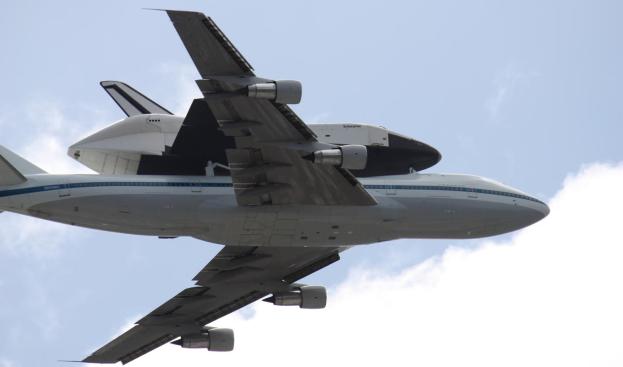
On its final trip through the air, the space shuttle Enterprise rode atop a modified jumbo 747 jet and mesmerized residents of New York City earlier today as reported by ABC News. Coming from Dulles International Airport in northern Virginia, the jet made a couple flyovers while over New York City. This allowed tourists to snap as many photos as possible while the shuttle passed locations like the Statue of Liberty, the new Freedom Tower, the Sept. 11 memorial in lower Manhattan as well as the location where Capt. Chesley Sullenberger splash-landed US Airways Flight 1549 in the Hudson River more than three years ago.

The shuttle was previously housed at the Smithsonian Institution in Washington D.C., but the giant spacecraft will be kept at the Intrepid Sea, Air and Space Museum on Manhattan’s west side in the future. According to Intrepid president Susan Marenoff-Zausner, she stated the new addition to the museum will be “the largest and most significant space artifact in the entire Northeast.” She continued “When somebody comes to visit, they will not only see the shuttle itself, but will have an engaging and interactive experience inside the pavilion.” Officials at the Intrepid plan to construct the pavilion over the spacecraft during the next two months and open up the attraction to visitors by the middle of July 2012.

The Enterprise will remain at the Kennedy Airport until early June. At that point, the shuttle will be placed on a barge and transported along the Hudson River to the Intrepid. While the Enterprise has never been sent into space, NASA used the craft to train astronauts during test flights in the atmosphere in addition to conducting experiments while the aircraft was grounded. Other NASA spacecraft are being transported around the country for display after the shuttle program came to an end last summer.

The space shuttle Atlantis will stay in Florida and be displayed at the Kennedy Space Center Visitor Complex. The $100 million exhibit is expected to by completed by summer of 2013. The new displays in New York City, Los Angeles and Florida are expected to increase visitor revenue significantly. According to Marenoff-Zausner, the new Enterprise display at the Intrepid Sea, Air and Space Museum is expected to increase annual visitors by 30 percent over the next year.
Photo Credit: Sean Cullinane, the “Ayatollah of Rock N Rollah”
Editors' Recommendations
- Why the moon needs a space traffic control system
- Watch SpaceX practice an emergency escape from its Crew Dragon capsule
- SpaceX selected to deliver cargo to NASA’s Lunar Gateway space station
- NASA suspends work on Space Launch System and Orion, may delay moon mission
- SpaceX and NASA still set for historic May mission despite coronavirus


